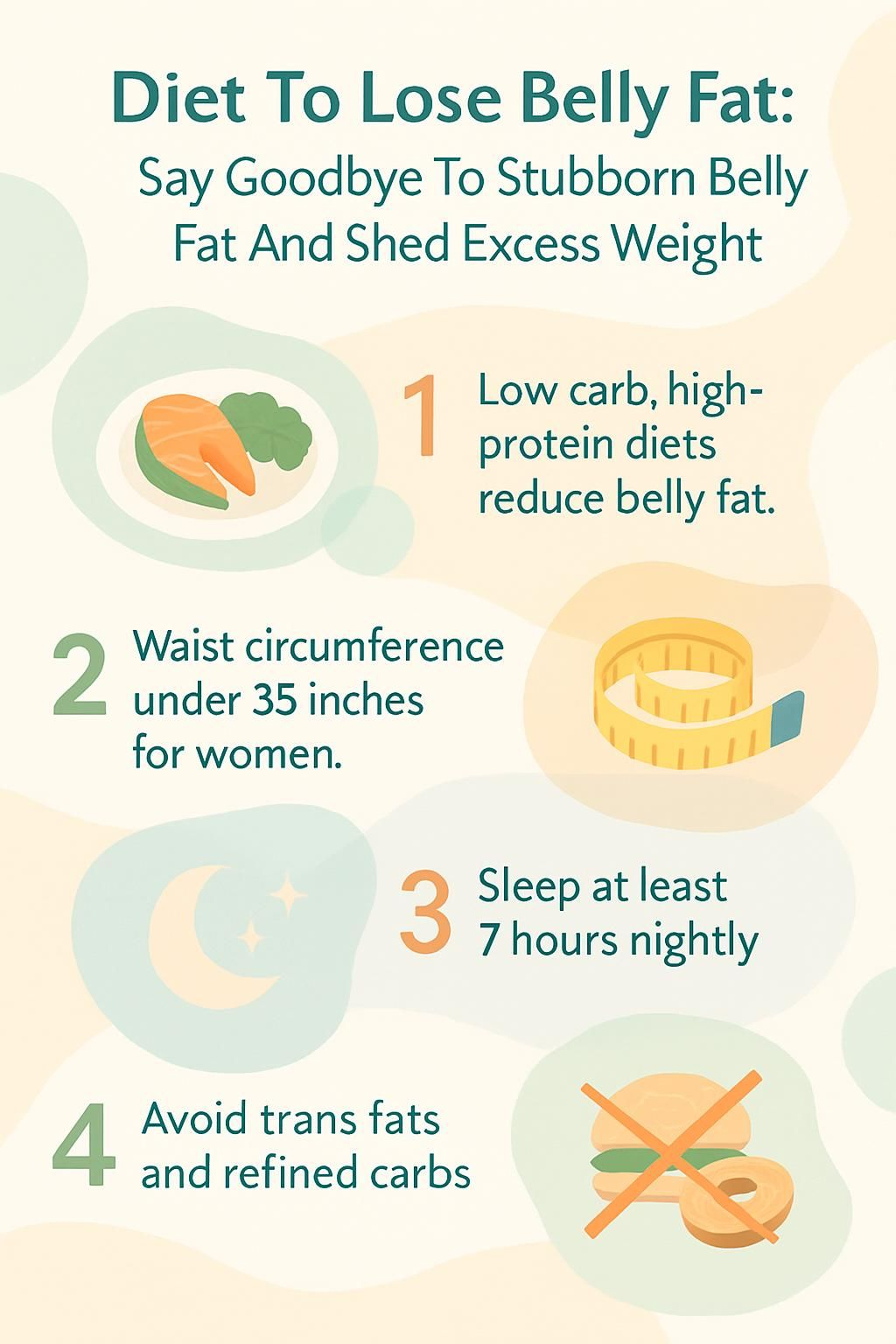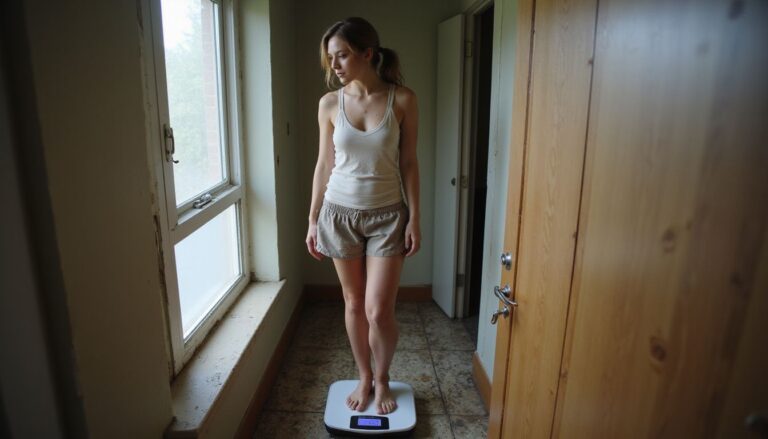Diet To Lose Belly Fat: Say Goodbye To Stubborn Belly Fat And Shed Excess Weight
Our Nutrition Assistant AI Suite will transform your body. You will lose fat, get toned, and build muscle. Gain confidence and optimal health.
You might feel stuck when your waistline will not shrink. Extra belly fat, especially visceral fat that surrounds organs, raises the risk of heart disease and type 2 diabetes. This guide gives clear steps, evidence, and simple habits to help you lose belly fat and lose weight safely.
You will see how nutrient-rich foods, smart portions, and steady exercise work together. Small daily choices stack up. Start now with tips you can use today.
Key Takeaways
- Low carb and higher protein plans with whole grains can reduce abdominal fat and improve artery function, as shown by Johns Hopkins and the Framingham Heart Study.
- Waist targets matter: women under 35 inches, men under 40 inches. Staying below these lines lowers the risk linked with visceral belly fat.
- A daily calorie deficit of about 500 to 750 calories supports fat loss. More soluble fiber, omega 3s from fish, and probiotics help, while sugary drinks slow progress.
- Sleeping seven or more hours reduces cravings and weight gain risk. A 2006 study in over 68,000 women linked short sleep to major weight gain.
- Cut trans fats, refined carbs like white bread, and added sugars. This aligns with FDA guidance for long term belly fat reduction.

Understanding Belly Fat

Belly fat sits in two main places. Subcutaneous fat is the soft layer under your skin. Visceral fat hides deeper in the abdomen around organs like the liver and kidneys. Knowing the difference helps you target health risks, not just appearance.
High levels of visceral fat raise the odds of heart disease, type 2 diabetes, and metabolic syndrome. Healthy habits that lower total body fat also trim this deeper fat over time.
What are the different types of belly fat?
Subcutaneous fat is pinchable and lies under your skin. Visceral fat, also called intra abdominal fat, surrounds internal organs. Intramuscular fat sits within muscle fibers.
Visceral fat has the strongest link to disease risk. Doctors often use waist circumference to screen for abdominal obesity. Goals are under 35 inches for women and under 40 inches for men.
Targeted fat loss from one body part is a myth. A steady weight loss plan reduces subcutaneous and visceral fat together. For example, a month of consistent diet and walking can shrink your waist even before your scale number drops.
Visceral belly fat is called the dangerous type because it strongly links to metabolic syndrome.
Lowering excessive belly fat improves blood sugar control, blood pressure, and long term heart health.
How does excess belly fat affect your health?
Visceral fat wraps around organs in the abdominal cavity. Too much raises the risk of heart disease, type 2 diabetes, fatty liver disease, and some cancers. Diets high in added sugar also drive high blood pressure and insulin resistance.
In a Johns Hopkins study, low carb diets improved artery function and sped weight loss compared with low fat plans. Poor sleep links to higher weight gain risk, especially in women who sleep less than five hours a night.
Excess visceral fat disrupts your body’s response to insulin, which can cause more fat storage. Better sleep, less added sugar, and balanced meals reduce inflammation and support healthy metabolism.
Next up, you will see why a calorie deficit is the engine of every successful weight loss plan.
Key Principles of a Belly Fat-Loss Diet
You need a clear, repeatable structure to reduce abdominal fat. A calorie deficit paired with smart food choices supports steady results and protects your health.
How do you create a caloric deficit to lose fat?
A calorie deficit means you burn more calories than you eat. Your body then uses stored fat for energy. Create that gap in small, sustainable steps.
- Track all food and drinks with a diary or app. Log calories, protein, carbohydrates, fiber, and added sugar.
- Set a daily calorie target using the Dietary Guidelines for Americans. Many adults aim for a 500 to 750 calorie daily deficit.
- Fill your eating plan with lean protein, whole grains, fruits, and vegetables. Limit sugary drinks and processed foods.
- Use portion control. Smaller plates, measured servings, and planned snacks keep you on target.
- Add aerobic exercise like brisk walking or cycling. Aim for at least 150 minutes per week plus two days of strength work.
- Increase daily movement, known as NEAT. Take extra steps, stand more, and add short active breaks.
- Track waist measurements and clothing fit, not only the scale. Waist changes often show up first when you lose belly fat.
- Consistent tracking helps you find hidden calories in sauces or drinks, which protects your deficit.
Small numbers add up. A 500 calorie daily gap can lead to about one pound of fat loss per week.
Which nutrient-dense foods help reduce belly fat?
Choose foods that satisfy hunger, support muscle, and steady blood sugar. These choices help you stick to your plan without feeling deprived.
Soluble fiber slows digestion and helps control appetite. Great sources include oats, barley, legumes, vegetables, and fruit. High protein foods such as fish, poultry, eggs, yogurt, beans, and whey powder preserve muscle while you lose fat.
Fatty fish like salmon and mackerel supply omega 3 fatty acids. Studies link these fats with less abdominal fat. Whole grains are linked with less belly fat in the Framingham Heart Study. Monounsaturated fats, found in olive oil, nuts, seeds, and avocados, support heart health and satiety.
Probiotic foods like yogurt with Lactobacillus strains can support a healthier gut, which may reduce visceral fat. Unsweetened green tea supplies caffeine and EGCG, compounds that can raise daily calorie burn.
What role do macronutrients play in fat loss?
Macronutrients are protein, carbohydrates, and fat. You need the right mix to reduce belly fat while keeping energy and muscle.
Protein increases fullness hormones and reduces hunger. Higher protein intakes correlate with less visceral fat and better body composition. Carbohydrate quality matters. Lower carb approaches often reduce waist size faster, especially in people with prediabetes or type 2 diabetes.
Choose healthy fats. Monounsaturated fats and omega 3s support heart health and may lower abdominal fat. Avoid trans fats. Replace refined carbs and sugars with fiber rich foods such as vegetables and whole grains to steady appetite and insulin.
A balanced plate supports daily activity while protecting your circulatory system and metabolism.
Essential Foods for Belly Fat Reduction
Some foods make it easier to control calories, appetite, and blood sugar. Build your meals around these staples to reduce abdominal fat more efficiently.
What are the best high-protein foods for belly fat loss?
Protein helps you feel full, keep muscle mass, and maintain a healthy weight while you cut calories. Include a quality source at each meal.
- Skinless chicken or turkey deliver lean protein that supports muscle and trims excess fat.
- Salmon, sardines, herring, and mackerel provide protein and omega 3s. Aim for two to three servings a week.
- Eggs are nutrient dense and help control appetite through hormones that signal fullness.
- Greek yogurt and cottage cheese add protein plus calcium. Choose options with minimal added sugar.
- Whey protein can fill gaps if eating enough protein is hard. Blend with fruit and spinach for a balanced shake.
- Beans, lentils, and chickpeas supply protein and fiber, a strong pair for fat loss.
- Almonds and walnuts add protein, fiber, and healthy fats that reduce snacking urges.
For busy weeks, prepare a batch of grilled chicken and a pot of lentils. You will have fast, high protein options ready for several meals.
Which fiber-rich foods support belly fat reduction?
Soluble fiber absorbs water and forms a gel in your gut. This slows digestion, steadies blood sugar, and supports appetite control, all helpful for belly fat loss.
- Oats: A top source of soluble fiber that keeps you full through the morning.
- Barley: Rich in soluble fiber and linked to lower rates of abdominal fat.
- Legumes: Beans, lentils, and peas balance blood sugar and cut hunger.
- Leafy greens: Spinach, kale, and similar greens add fiber with very few calories.
- Fruit: Apples, oranges, pears, and berries bring fiber and antioxidants.
- Whole grain cereals: Choose options with higher fiber and low added sugar.
- Nuts: Almonds, walnuts, and pistachios fight cravings when eaten in moderation.
- Vegetables like carrots and broccoli raise fiber quickly at lunch or dinner.
Aim to add one fiber food at every meal. For example, pair eggs with berries at breakfast, then add beans and greens at lunch.
What healthy fats should you include in your diet?
Healthy fats support hormone balance, brain function, and steady energy. The right fats also help you feel satisfied on fewer calories.
- Fatty fish such as salmon, sardines, and herring deliver omega 3s that support heart and metabolic health.
- Extra virgin olive oil provides monounsaturated fats that can reduce inflammation and support a leaner waist.
- Nuts like almonds and walnuts make filling snacks and supply fiber plus protein.
- Avocados add fiber and monounsaturated fats that keep meals satisfying.
- Seeds such as chia and flax offer plant based omega 3s for daily balance.
- Algae based omega 3 supplements work well if you avoid fish.
- Avoid foods with partially hydrogenated oils. These trans fats increase inflammation and belly fat.
- Choose nut butters over high sugar spreads for more nutrients per serving.
How do probiotics help with belly fat loss?
Probiotics are live bacteria that support a healthy gut. A balanced gut can lower inflammation and improve how your body uses and stores energy.
Certain Lactobacillus strains are linked with less visceral fat in reviews and meta analyses. Yogurt, kefir, and fermented vegetables are easy ways to add them. Many people also report less bloating after a few weeks of use.
Speak with a healthcare professional before starting supplements, especially if you have medical conditions or take medications.
Better gut health can support weight control with fewer changes to your daily routine.
Which metabolism-boosting drinks aid fat loss?
What you drink can help or harm your progress. Choose low calorie options that support hydration and a modest bump in calorie burn.
- Green tea provides caffeine and EGCG, compounds that can raise fat burning. Twelve weeks of use often shows benefits.
- Water is calorie free and helps control portions when you drink it before meals.
- Unsweetened iced tea adds flavor without sugar or extra calories.
- Black coffee can boost workout energy. Skip sugar and heavy creamers.
- Lemon water tastes fresh with no fructose load like juice.
- Sparkling water offers fizz without the sugar found in soda.
- Avoid sugary drinks like soda, juice cocktails, sweet teas, and mixed alcohols.
Set a simple rule. Drink water first at every meal, then add tea or coffee as desired.
Foods to Avoid for Reducing Belly Fat
Some foods make it easy to overeat or spike blood sugar. Reducing them helps you create a calorie deficit and lower abdominal fat faster.
Why should you cut out sugary drinks and processed sugars?
Added sugar drives weight gain, especially around the belly. Liquid sugar is the biggest trap because it adds calories without fullness.
- High sugar intake links to heart disease, type 2 diabetes, and fatty liver, problems tied to visceral fat.
- Fructose heavy drinks, such as soda and sweet teas, push fat storage in the midsection.
- Processed foods hide added sugars under many names, making it easy to overeat.
- Even unsweetened apple juice has about 24 grams of sugar per serving, which adds up quickly.
- Liquid calories do not curb appetite like solid food. You keep drinking and add calories fast.
- Reading labels helps you dodge hidden sugar in yogurts, sauces, and snacks.
- Major health groups report that most people exceed daily limits for added sugar.
Swapping soda for water or unsweetened tea can cut hundreds of calories each week.
What refined carbs and breads increase belly fat?
Refined grains are stripped of fiber. They digest fast, spike blood sugar, and raise insulin, which can promote fat storage.
- White bread causes quick blood sugar spikes and can add belly fat.
- Pastries, muffins, and cookies pack calories from refined flour and sugar.
- Soft rolls, baguettes, and many sandwich breads use enriched flour with little fiber.
- Packaged tortillas or wraps with enriched wheat flour digest quickly and leave you hungry.
- Snack crackers often combine refined flour and oils for lots of empty calories.
- Fast food buns and pizza crusts rely on refined flour that drives insulin up.
- The Framingham Heart Study linked higher whole grain intake to a 17 percent lower risk of extra abdominal fat.
Choose whole grain breads, oatmeal, brown rice, or quinoa to steady energy and appetite.
How do trans fats and processed foods affect belly fat?
Trans fats and many processed foods increase inflammation and make fat loss harder. These products are calorie dense and easy to overeat.
- Trans fats form when oils are hydrogenated to become solid. They show up in some packaged snacks and fried foods.
- Eating trans fats is tied to more abdominal fat and higher heart disease risk.
- Studies show people who eat more trans fats tend to carry more belly fat.
- Processed foods often contain added sugars, high sodium, and poor quality oils.
- The FDA banned most added trans fats in 2018, yet labels still deserve close attention.
- Refined breads and crackers can spike blood sugar, which encourages fat storage.
- Scan labels for words like partially hydrogenated oil or shortening and skip those items.
- Relying on these foods may reduce muscle and raise fat, the opposite of your goal.
- Shifting to whole foods improves your odds of long term weight control.
- Build meals around protein, fiber, healthy fats, and probiotic foods to support progress.
How to Plan Meals for Belly Fat Loss
Planning removes guesswork. With a simple plan, you control portions, include nutrient dense foods, and keep your deficit steady.
How do you design a weekly meal plan for fat loss?
A weekly plan saves time and reduces stress. It also prevents last minute choices that add calories without nutrition.
- Pick a calorie target that creates a small daily deficit. Track intake with an app.
- Include protein at every meal to protect muscle while losing fat.
- Choose whole grains such as oats and barley instead of white bread or regular pasta.
- Schedule two fatty fish meals each week for omega 3s.
- Plan daily soluble fiber from beans, lentils, fruit, and vegetables.
- Add probiotic foods like yogurt for gut health support.
- Limit processed foods with added sugars or trans fats.
- Set regular meal and snack times to steady hunger and portions.
- Use water or green tea in place of sugary drinks.
- Track protein, carbs, fiber, and water each day so adjustments are easy.
Prep once, eat well all week. Cook grains and proteins in batches, then mix and match with vegetables.
What are effective portion control and mindful eating tips?
Portion control and mindful eating help you eat less without feeling deprived. These skills prevent mindless overeating.
- Use smaller plates and bowls to make normal servings look generous.
- Check how your waistband fits each week. It is a practical sign of belly fat loss.
- Fill half your plate with vegetables to add volume and fiber.
- Limit high calorie snacks and sweet drinks to protect your calorie deficit.
- Eat slowly and pause between bites so fullness signals can catch up.
- Track your meals to learn your habits. Logging improves success rates.
- Avoid distracted eating during screen time. Sit down for all meals and snacks.
Practice one skill at a time. For example, start with smaller plates this week, then add slow eating next week.
How do you prepare balanced meals with key nutrients?
Balanced plates make fat loss simpler. Aim for protein, colorful produce, quality carbs, and healthy fats at each meal.
- Add protein such as eggs, fish, chicken, beans, or Greek yogurt to every meal.
- Fill half the plate with vegetables like broccoli, spinach, carrots, or peppers.
- Pick whole grains like oats, brown rice, or quinoa instead of refined bread.
- Include healthy fats from olive oil, avocados, nuts, and seeds.
- Measure portions: 3 to 4 ounces of protein, a half cup cooked grains, and one tablespoon of oils.
- Plan the week in advance to avoid rushed choices.
- Add probiotic foods like low sugar yogurt to support gut health.
- Aim for a simple split, such as 30 percent protein, 30 percent fat from plants, and 40 percent complex carbs.
- Use baking, grilling, or steaming to keep calories down.
- Consider green tea or black coffee without sugar alongside meals.
Consistent sleep of seven hours or more supports appetite control and better meal choices the next day.
Lifestyle Changes to Reduce Belly Fat
Daily habits shape how your body stores and burns fat. Stress, sleep, and movement patterns all influence your waistline.
How does stress impact belly fat and how to manage it?
Chronic stress raises cortisol, a hormone that can increase fat storage in the belly. Women with larger waists often show higher cortisol responses during stress.
Overtraining also raises cortisol, which can stall progress. Moderate activity such as brisk walking for about an hour helps reduce stress without overloading your body.
Use tools that calm your nervous system. Try yoga, meditation, or breathing drills most days. If you sit eight to nine hours, add short movement breaks. Light stretching or a five minute walk counts.
Daily movement outside of workouts, called NEAT, offsets long sitting time. Supportive friends or groups can also reduce emotional strain and help you stick with your eating plan.
Why is quality sleep important for losing belly fat?
Sleep is a powerful fat loss tool. Large studies show sleeping under five hours increases the chance of gaining 30 or more pounds compared with seven or more hours.
Short sleep disrupts hunger hormones. You feel hungrier and crave high calorie foods, which increases abdominal fat. Better sleep also helps your arteries and improves results from diet changes.
If you have sleep apnea, seek treatment. Apnea is tied to more visceral fat and poor recovery. Muscle repair happens at night, so strength training results improve when you sleep enough.
Set a wind down routine, keep a regular bedtime, and dim screens. Small changes make restful nights more likely.
How much water should you drink daily for fat loss?
Aim for at least eight cups, about two liters, of water daily. Water is calorie free and supports portion control when you drink it before meals.
Carry a bottle to track intake and replace sugary drinks. Proper hydration improves exercise performance and digestion. If you want variety, choose unsweetened iced tea or sparkling water.
Hydration needs vary with activity, age, and climate. Keep water as your main drink for the best weight control support.
Exercise Approaches to Target Belly Fat
Exercise multiplies the effect of a healthy diet. Think of it as a partner that speeds calorie burn and protects muscle.
How can diet and exercise be combined to lose belly fat?
Use both. A calorie deficit from food plus activity helps your body tap stored fat, including stubborn belly fat.
Research in teens showed the biggest drop in visceral fat when aerobic exercise and strength training were combined. Aim for 30 to 60 minutes of moderate to vigorous activity most days.
Track both workouts and food. Resistance training builds muscle, which raises your resting calorie burn. Add standing breaks and short walks during the day for extra movement.
Small steps matter. A 15 minute walk after meals can improve blood sugar and support waist loss.
What cardiovascular exercises help reduce belly fat?
Cardio burns calories and supports heart health. Choose activities you can repeat often, then increase time or intensity gradually.
- Brisk walking is joint friendly and fits most schedules. Aim for 150 minutes per week.
- Jogging or running burns more calories per minute. Use soft surfaces to reduce impact.
- Group classes and team sports add social support that keeps you consistent.
- Swimming and cycling are excellent low impact choices for higher calorie burn.
- High Intensity Interval Training alternates hard efforts and short rests for time efficient results.
- Boost daily movement with standing breaks and extra steps if you sit most of the day.
- In a study of postmenopausal women, 300 minutes per week of aerobic exercise reduced more fat than 150 minutes.
Pick a mix you enjoy. Consistency beats perfection for long term fat loss.
How does strength training aid belly fat loss?
Strength training protects and builds lean muscle. More muscle raises your resting metabolism, which means you burn more calories all day.
- Resistance work helps prevent muscle loss during weight loss.
- Muscle tissue uses more energy at rest than fat tissue.
- Short rest periods and challenging loads can increase post workout calorie burn.
- Pairing strength and cardio reduces visceral fat better than either alone.
- People with prediabetes, type 2 diabetes, or fatty liver often see improved waist measurements.
- Body composition improves as fat goes down and muscle increases.
- More muscle also improves insulin sensitivity, which helps reduce fat storage.
Start with two to three full body sessions weekly. Focus on big moves like squats, rows, presses, and hip hinges.
What is HIIT and how does it target belly fat?
High Intensity Interval Training, or HIIT, alternates intense bursts with short recovery periods. This structure burns calories quickly and improves cardio fitness.
Studies show HIIT can reduce waist size and improve insulin sensitivity. It may also raise post exercise calorie burn due to its intensity.
Try 20 minutes of intervals two to three days per week. Balance hard days with easier activity and good sleep to avoid excess cortisol.
Check with your clinician before starting HIIT if you are new to exercise or have health concerns.
Popular Diets for Belly Fat Reduction
Several eating patterns can help reduce abdominal fat. Choose the one that fits your life and health needs, then follow it consistently.
How does intermittent fasting work for belly fat loss?
Intermittent fasting cycles between windows of eating and fasting. Popular styles include 16:8 fasting or an occasional 24 hour fast.
Fasting narrows your eating window, which often creates a calorie deficit. A 2022 study found that pairing fasting with high protein meals led to greater weight loss and more belly fat reduction than calorie cutting alone.
Keep meals nutrient dense and hydrate well. People with medical conditions, those who are pregnant, or anyone on medications should talk with a healthcare professional first.
What are the benefits of low-carb and ketogenic diets?
Low carb and ketogenic diets lower insulin levels, which helps your body burn more fat. In a Johns Hopkins trial, people on a low carb plan lost about 29 pounds in six months versus about 19 pounds on a low fat plan.
These diets often improve blood sugar control and artery function. They can be useful for overweight adults and those with prediabetes, type 2 diabetes, or PCOS.
The key is quality. Focus on protein, nonstarchy vegetables, and healthy fats while limiting refined carbs and added sugars.
Why is the Mediterranean diet effective for belly fat?
The Mediterranean diet emphasizes whole foods, fiber, and healthy fats. Fruits, vegetables, legumes, nuts, and whole grains slow digestion and support fullness.
Olive oil and nuts replace less healthy fats. Fatty fish adds omega 3s, which studies associate with less visceral fat. Regular physical activity is also part of the pattern.
This plan is flexible and easier to maintain long term, which supports steady weight control and a smaller waistline.
Common Myths About Belly Fat Loss
Misinformation can waste time and money. Clearing up myths helps you focus on strategies that work.
Is it possible to target belly fat specifically?
No. Spot reduction does not work. You cannot choose where fat leaves first.
A calorie deficit reduces total body fat. Aerobic exercise and strength training together help shrink both subcutaneous fat and visceral fat.
For example, many people see belts fit looser within weeks of walking regularly, even without special ab workouts.
Are quick fixes and miracle pills effective for fat loss?
Quick fixes and miracle pills do not create lasting change. Many lack solid scientific evidence and cannot target belly fat specifically.
Real progress comes from consistent habits, a calorie deficit, and regular activity. Save your budget for quality food and supportive tools that you will use.
If a product sounds too good to be true, talk with a healthcare professional before trying it.
Tracking Progress and Staying Motivated
Tracking provides proof that your plan is working. Small wins build momentum and keep you engaged.
How do you measure changes in your waistline and body?
Use simple, repeatable checks to track abdominal fat loss. Numbers and visuals together tell a clearer story than the scale alone.
- Measure waist circumference at the navel once a week. Targets are under 35 inches for women and under 40 inches for men.
- Notice how your jeans, belts, and shirts fit. Looser clothing often shows early wins.
- Take photos every two to four weeks from front, side, and back in similar clothes.
- Weigh in at the same time each week on the same scale for trends, not daily swings.
- Log measurements and meals in a diary or app to spot patterns.
- Stay active 30 to 60 minutes most days to support ongoing belly fat reduction.
- Use a mirror check for posture, muscle tone, and midsection changes.
Mixing these tools keeps motivation up and removes guesswork.
Why is celebrating small achievements important?
Progress can feel slow. Celebrating small wins reinforces the habits that create change.
Short term goals, such as hitting your protein target each day, build confidence. Sharing milestones with a friend or group increases accountability during tougher weeks.
Choose nonfood rewards, like new workout socks or a relaxing activity, to mark each step forward.
How can you commit to lasting lifestyle changes?
Consistency beats intensity. Daily tracking, simple routines, and a supportive circle make your plan stick.
Manage stress with brief, regular practices. Keep a steady sleep schedule. Join a walking group or class if community helps you stay engaged.
These steps put you in control and make weight management part of your normal week.
Conclusion
Losing belly fat takes steady work and smart choices. Build meals around lean protein, fiber rich produce, whole grains, and healthy fats. Cut sugary drinks and refined carbs. Combine your eating plan with aerobic exercise and strength training for the best results.
Protect your progress with stress control and at least seven hours of sleep each night. Track waist size and celebrate small wins to stay motivated. With patience and consistency, you can reduce visceral fat, trim your waistline, and feel healthier every day.
Health disclaimer: This content is educational and not a substitute for medical advice. Speak with a qualified healthcare professional before making major diet, exercise, or supplement changes, especially if you have medical conditions or take medications.Sources: Johns Hopkins Medicine on low carb diet effects [2012], Framingham Heart Study findings on whole grains and abdominal fat, and large cohort sleep studies on weight gain risk [2006 and later].
FAQs
1. What foods help reduce belly fat most effectively?
Whole grains, lean poultry, fish, legumes, leafy greens, and berries support weight loss around the waist. These foods are high in fiber and protein but low in added sugar and saturated fats. Studies show that diets rich in these nutrients can lower abdominal fat over time (Smith et al., 2020).
2. How does exercise impact stubborn belly fat?
Aerobic activities like brisk walking or swimming burn calories and target visceral fat stored deep within the abdomen. Strength training also helps by building muscle mass which increases metabolism at rest (Harvard Health Publishing). Combining both types of activity leads to greater reductions in waist size.
3. Can cutting out certain drinks help shed excess weight from the midsection?
Yes; removing sugary sodas, sweetened teas, and alcohol reduces calorie intake significantly. Research links these beverages to increased abdominal obesity due to their high sugar content (CDC Nutrition Report). Replacing them with water or unsweetened tea supports a flatter stomach.
4. Is there scientific proof that specific diets work better for losing belly fat?
Evidence suggests that Mediterranean-style eating patterns lead to more significant decreases in central body fat compared to low-fat plans (Estruch et al., 2018). This approach emphasizes vegetables, olive oil, nuts, seafood, and whole grains while limiting processed items.
Summary: Eating nutrient-rich meals focused on whole ingredients aids belly fat reduction when paired with regular physical activity. Avoiding sugary drinks further improves results according to current research findings.
Personal Note: After switching my breakfast from pastries to oatmeal topped with fruit for three months I noticed my waistband felt looser even before stepping on a scale.
Data Table:
| Food Group | Effect on Belly Fat|
|——————–|————————-|
| Whole Grains | Reduces |
| Leafy Greens | Reduces |
| Lean Poultry/Fish| Supports Loss |
| Sugary Drinks| Increases |
| Processed Foods| Increases |
References:
– Smith J et al., “Dietary Fiber Intake Reduces Abdominal Obesity,” Journal of Nutrition Science (2020).
– Harvard Health Publishing: “The Truth About Belly Fat.”
– Estruch R et al., “Mediterranean Diet for Primary Prevention of Cardiovascular Disease,” New England Journal of Medicine (2018).
– CDC Nutrition Report







